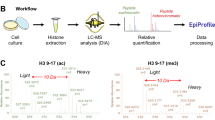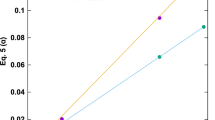Abstract
Current proteomic approaches disassemble and digest nucleosome particles, blurring readouts of the ‘histone code’. To preserve nucleosome-level information, we developed Nuc-MS, which displays the landscape of histone variants and their post-translational modifications (PTMs) in a single mass spectrum. Combined with immunoprecipitation, Nuc-MS quantified nucleosome co-occupancy of histone H3.3 with variant H2A.Z (sixfold over bulk) and the co-occurrence of oncogenic H3.3K27M with euchromatic marks (for example, a >15-fold enrichment of dimethylated H3K79me2). Nuc-MS is highly concordant with chromatin immunoprecipitation-sequencing (ChIP-seq) and offers a new readout of nucleosome-level biology.
This is a preview of subscription content, access via your institution
Access options
Access Nature and 54 other Nature Portfolio journals
Get Nature+, our best-value online-access subscription
$29.99 / 30 days
cancel any time
Subscribe to this journal
Receive 12 print issues and online access
$259.00 per year
only $21.58 per issue
Buy this article
- Purchase on Springer Link
- Instant access to full article PDF
Prices may be subject to local taxes which are calculated during checkout



Similar content being viewed by others
Data availability
MS1, MS2 and MS3 spectra presented in the paper are available online in the MassIVE database under accession code MSV000085238 and can be visualized with Thermo Qual Browser. Source data are provided with this paper.
References
Moller, J. & de Pablo, J. J. Bottom–up meets top–down: the crossroads of multiscale chromatin modeling. Biophys. J. 118, 2057–2065 (2020).
Campos, E. I. & Reinberg, D. Histones: annotating chromatin. Annu. Rev. Genet. 43, 559–599 (2009).
Bannister, A. J. & Kouzarides, T. Regulation of chromatin by histone modifications. Cell Res. 21, 381–395 (2011).
Portela, A. & Esteller, M. Epigenetic modifications and human disease. Nat. Biotechnol. 28, 1057–1068 (2010).
Patel, D. J. & Wang, Z. Readout of epigenetic modifications. Annu. Rev. Biochem. 82, 81–118 (2013).
Zink, L. M. & Hake, S. B. Histone variants: nuclear function and disease. Curr. Opin. Genet. Dev. 37, 82–89 (2016).
Ruthenburg, A. J., Li, H., Patel, D. J. & Allis, C. D. Multivalent engagement of chromatin modifications by linked binding modules. Nat. Rev. Mol. Cell Biol. 8, 983–994 (2007).
Ichikawa, Y. et al. A synthetic biology approach to probing nucleosome symmetry. eLife 6, e28836 (2017).
Voigt, P. et al. Asymmetrically modified nucleosomes. Cell 151, 181–193 (2012).
Zheng, Y., Huang, X. & Kelleher, N. L. Epiproteomics: quantitative analysis of histone marks and codes by mass spectrometry. Curr. Opin. Chem. Biol. 33, 142–150 (2016).
Shah, R. N. et al. Examining the roles of H3K4 methylation states with systematically characterized antibodies. Mol. Cell 72, 162–177 (2018).
Compton, P. D., Kelleher, N. L. & Gunawardena, J. Estimating the distribution of protein post-translational modification states by mass spectrometry. J. Proteome Res. 17, 2727–2734 (2018).
Belov, M. E. et al. From protein complexes to subunit backbone fragments: a multi-stage approach to native mass spectrometry. Anal. Chem. 85, 11163–11173 (2013).
Azegami, N. et al. Conclusive evidence of the reconstituted hexasome proven by native mass spectrometry. Biochemistry 52, 5155–5157 (2013).
Lercher, L. et al. Generation of a synthetic GlcNAcylated nucleosome reveals regulation of stability by H2A-Thr101 GlcNAcylation. Nat. Commun. 6, 7978 (2015).
Jin, C. et al. H3.3/H2A.Z double variant-containing nucleosomes mark ‘nucleosome-free regions’ of active promoters and other regulatory regions. Nat. Genet. 41, 941–945 (2009).
Cui, K. et al. Chromatin signatures in multipotent human hematopoietic stem cells indicate the fate of bivalent genes during differentiation. Cell Stem Cell 4, 80–93 (2009).
Talasz, H., Lindner, H. H., Sarg, B. & Helliger, W. Histone H4-lysine 20 monomethylation is increased in promoter and coding regions of active genes and correlates with hyperacetylation. J. Biol. Chem. 280, 38814–38822 (2005).
Svensson, J. P. et al. A nucleosome turnover map reveals that the stability of histone H4 Lys20 methylation depends on histone recycling in transcribed chromatin. Genome Res. 25, 872–883 (2015).
Lulla, R. R., Saratsis, A. M. & Hashizume, R. Mutations in chromatin machinery and pediatric high-grade glioma. Sci. Adv. 2, e1501354 (2016).
Herz, H.-M. et al. Histone H3 lysine-to-methionine mutants as a paradigm to study chromatin signaling. Science 345, 1065–1070 (2014).
Brumbaugh, J. et al. Inducible histone K-to-M mutations are dynamic tools to probe the physiological role of site-specific histone methylation in vitro and in vivo. Nat. Cell Biol. 21, 1449–1461 (2019).
Piunti, A. et al. Therapeutic targeting of polycomb and BET bromodomain proteins in diffuse intrinsic pontine gliomas. Nat. Med. 23, 493–500 (2017).
Taylor, G. C. A., Eskeland, R., Hekimoglu-Balkan, B., Pradeepa, M. M. & Bickmore, W. A. H4K16 acetylation marks active genes and enhancers of embryonic stem cells, but does not alter chromatin compaction. Genome Res. 23, 2053–2065 (2013).
Nguyen, A. T. & Zhang, Y. The diverse functions of Dot1 and H3K79 methylation. Genes Dev. 25, 1345–1358 (2011).
Sweet, S. M. M., Li, M., Thomas, P. M., Durbin, K. R. & Kelleher, N. L. Kinetics of re-establishing H3K79 methylation marks in global human chromatin. J. Biol. Chem. 285, 32778–32786 (2010).
Wang, Y. et al. Histone variants H2A.Z and H3.3 coordinately regulate PRC2-dependent H3K27me3 deposition and gene expression regulation in mES cells. BMC Biol. 16, 107 (2018).
Lowe, B. R., Maxham, L. A., Hamey, J. J., Wilkins, M. R. & Partridge, J. F. Histone H3 mutations: an updated view of their role in chromatin deregulation and cancer. Cancers 11, 660 (2019).
Talbert, P. B. & Henikoff, S. Histone variants—ancient wrap artists of the epigenome. Nat. Rev. Mol. Cell Biol. 11, 264–275 (2010).
Skene, P. J. & Henikoff, S. An efficient targeted nuclease strategy for high-resolution mapping of DNA binding sites. eLife 6, e21856 (2017).
Huang, C. et al. H3.3–H4 tetramer splitting events feature cell-type specific enhancers. PLoS Genet. 9, e1003558 (2013).
Zhao, Z. & Shilatifard, A. Epigenetic modifications of histones in cancer. Genome Biol. 20, 245 (2019).
Luger, K., Mader, A. W., Richmond, R. K., Sargent, D. F. & Richmond, T. J. Crystal structure of the nucleosome core particle at 2.8 Å resolution. Nature 389, 251–260 (1997).
Lee, T. I., Johnstone, S. E. & Young, R. A. Chromatin immunoprecipitation and microarray-based analysis of protein location. Nat. Protoc. 1, 729–748 (2006).
Vo, B. et al. Inactivation of Ezh2 upregulates Gfi1 and drives aggressive Myc-driven Group 3 medulloblastoma. Cell Rep. 18, 2907–2917 (2017).
Andrews, S. FastQC: a quality control tool for high throughput sequence data. Babraham Bioinformatics http://www.bioinformatics.babraham.ac.uk/projects/fastqc (2010).
Langmead, B., Trapnell, C., Pop, M. & Salzberg, S. L. Ultrafast and memory-efficient alignment of short DNA sequences to the human genome. Genome Biol. 10, R25 (2009).
Zhang, Y. et al. Model-based Analysis of ChIP-seq (MACS). Genome Biol. 9, R137 (2008).
Heinz, S. et al. Simple combinations of lineage-determining transcription factors prime cis-regulatory elements required for macrophage and B cell identities. Mol. Cell 38, 576–589 (2010).
Ross-Innes, C. S. et al. Differential oestrogen receptor binding is associated with clinical outcome in breast cancer. Nature 481, 389–393 (2012).
Yu, G., Wang, L.-G., Han, Y. & He, Q.-Y. clusterProfiler: an R package for comparing biological themes among gene clusters. OMICS 16, 284–287 (2012).
Ramírez, F. et al. deepTools2: a next generation web server for deep-sequencing data analysis. Nucleic Acids Res. 44, W160–W165 (2016).
Edgar, R., Domrachev, M. & Lash, A. E. Gene Expression Omnibus: NCBI gene expression and hybridization array data repository. Nucleic Acids Res. 30, 207–210 (2002).
Schachner, L. F., Lee, A. & Kelleher, N. L. Protocol for decoding the protein composition of whole nucleosomes with Nuc-MS: sample preparation, data acquisition and analysis. Protocol Exchange https://doi.org/10.21203/rs.3.pex-1288/v1 (2020).
Zhang, Z. & Marshall, A. G. A universal algorithm for fast and automated charge state deconvolution of electrospray mass-to-charge ratio spectra. J. Am. Soc. Mass Spectrom. 9, 225–233 (1998).
Marty, M. T. et al. Bayesian deconvolution of mass and ion mobility spectra: from binary interactions to polydisperse ensembles. Anal. Chem. 87, 4370–4376 (2015).
Fellers, R. T. et al. ProSight Lite: graphical software to analyze top–down mass spectrometry data. Proteomics 15, 1235–1238 (2015).
Fornelli, L. et al. Accurate sequence analysis of a monoclonal antibody by top–down and middle–down orbitrap mass spectrometry applying multiple ion activation techniques. Anal. Chem. 90, 8421–8429 (2018).
Bland, J. M. & Altman, D. G. Multiple significance tests: the Bonferroni method. BMJ 310, 170 (1995).
Kafader, J. O. et al. Multiplexed mass spectrometry of individual ions improves measurement of proteoforms and their complexes. Nat. Methods 17, 391–394 (2020).
Acknowledgements
This work was supported by the National Institute of General Medical Sciences (P41 GM108569) for the National Resource for Translational and Developmental Proteomics at Northwestern University and NIH grants S10OD025194 and RF1AG063903 (Kelleher laboratory) and R44GM116584, R44CA212733 and R44CA214076 (EpiCypher). L.F.S. is a Gilliam Fellow of the Howard Hughes Medical Institute. Research in this publication is also supported by Thermo Fisher Scientific and a fellowship associated with the Chemistry of Life Processes Predoctoral Training grant T32GM105538 at Northwestern University. A.P. is supported by the Transition to Independence grant K99CA234434-01. We also thank M. Senko, P. Compton, C. Koo, L. Szymczak and M. McAnnally for technical assistance and S. Judge and A. Rosenzweig for providing thoughtful suggestions to improve the manuscript.
Author information
Authors and Affiliations
Contributions
L.F.S. performed Nuc-MS data acquisition and analysis. K.J. assisted with proteoform quantitation and MS analysis. A.P., M.A.M., A.S.L. and A.S. prepared and made available H3.3K27M-FLAG and H3.3WT-FLAG mononucleosomes. M.A.M. and M.I. conducted and analyzed ChIP-seq experiments. J.O.K. assisted with acquisition of multiplexed I2MS data on endogenous nucleosomes. M.J.M., M.A.C., J.M.B. and S.A.H. assisted with synthesis, purification and verification of modified nucleosomes. M.-C.K. coordinated modified nucleosome synthesis and provided insightful feedback on the manuscript. L.F.S. and N.L.K. conceived the project and wrote the manuscript.
Corresponding author
Ethics declarations
Competing interests
N.L.K. serves as a consultant to Thermo Fisher Scientific. EpiCypher is a commercial developer and supplier of reagents, including the recombinant semi-synthetic modified nucleosomes (dNucs) used in this study. The other authors declare no competing interests.
Additional information
Peer review information Arunima Singh was the primary editor on this article and managed its editorial process and peer review in collaboration with the rest of the editorial team.
Publisher’s note Springer Nature remains neutral with regard to jurisdictional claims in published maps and institutional affiliations.
Supplementary information
Supplementary Information
Supplementary Figs. 1–19, Tables 1–3 and Protocol.
Supplementary Data 1
Statistical source data and analysis for quantitative comparison of two equimolar synthetic Nucs presented in Supplementary Fig. 4b.
Supplementary Data 2
Statistical source data and analysis for quantitative comparison of H3.3 and HEK293T bulk Nucs presented in Supplementary Fig. 9.
Supplementary Data 3
Statistical source data and analysis for quantitative comparison of H3.3K27M fragments that localize to K79me2 in Supplementary Fig. 14.
Supplementary Data 4
Uncropped western blots for data presented in Supplementary Fig. 17.
Source data
Source Data Fig. 3
Statistical source data and analysis for quantitative comparison of H3.3K27M and WT Nucs presented in Fig. 3c–e.
Rights and permissions
About this article
Cite this article
Schachner, L.F., Jooß, K., Morgan, M.A. et al. Decoding the protein composition of whole nucleosomes with Nuc-MS. Nat Methods 18, 303–308 (2021). https://doi.org/10.1038/s41592-020-01052-9
Received:
Accepted:
Published:
Issue Date:
DOI: https://doi.org/10.1038/s41592-020-01052-9
This article is cited by
-
Exposing the molecular heterogeneity of glycosylated biotherapeutics
Nature Communications (2024)



